|
Working Together for International Migratory Bird Conservation
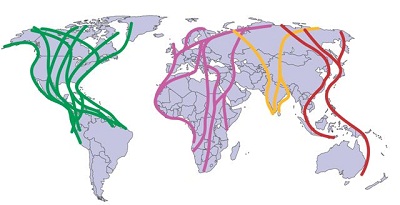
It is difficult for humans to grasp just how far migratory birds travel each year. As shown by the global flyways map (right) migratory birds can travel incredible distances across continents, oceans and even hemispheres during their migrations along routes, also known as flyways. As they travel along these vast flyways, migratory birds are heedless of the many political borders that they cross that are shared by all countries along migratory bird flyways. Migratory birds use networks of sites that act like 'stepping stones' along flyways and are important for resting, feeding, breeding and
wintering. Many sites that birds depend on are under threat from direct human activities such as land reclamation and deforestation, as well as indirect human influences, such as climate change, damage these sites through habitat fragmentation and degradation. Large numbers of important sites have already been damaged, or lost entirely.
The dangers migratory birds face in different countries along migration
routes vary immensely depending on political, economic and environmental situations, yet birds have no choice but to face the many dangers caused by humans
as they fly from country to country. Further, the loss of just one of these important bird sites can endanger migratory birds that are shared by all countries along the flyway.
That is why it is so important for governments, conservation organizations, scientists, and ordinary people around the world to work together to conserve migratory birds.
What Happens When an Important Site for Migratory Birds Is Lost
 Often when migratory birds arrive at important sites during their migrations, they are hungry and exhausted. They need to rest and feed before migrating further. That is why when the birds arrive to find the sites damaged or even completely destroyed, it can mean less food, less rest and even death. Often when migratory birds arrive at important sites during their migrations, they are hungry and exhausted. They need to rest and feed before migrating further. That is why when the birds arrive to find the sites damaged or even completely destroyed, it can mean less food, less rest and even death.
An example of an important migratory bird site that was greatly damaged by human activity is the
Saemangeum Estuary in Yellow Sea region in the Republic of Korea. As part of a land reclamation
project of enormous proportions, estuaries, tidal flats and sea shallows have been drained, filled and converted to land
to be used for human activities. The tidal flats and sea shallows alone
encompass an area of over 400 square kilometres. This conversion has been
achieved by building a seawall, measuring 33
kilometres that encircles the Saemangeum tidal flats. [Where is the Saemangeum Estuary?]
Scientists
estimate that the reclamation project has led to a decline of 137,000
shorebirds, due to the degradation of this formerly extremely valuable migration site. The damage of the reclamation project can easily be seen from space in before and after photos. ['Before' and 'After' Photos of the Saemangeum]
The birds that relied on Saemanguem were shared between all the countries along the flyway. Yet the loss of one site in one country resulted in a devastating impact for birds shared by many countries. The
land reclamation of the Saemangeum illustrates well the importance of networks of sites that birds use along migration routes and why governments, conservation organizations, scientists, and ordinary people
around the world must work together.
Networks of Governments for Migratory Bird Conservation
The Agreement on the Conservation of African-Eurasian
Migratory Waterbirds (AEWA)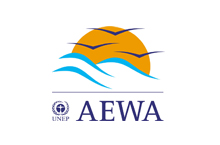 The Agreement on the Conservation of African-Eurasian
Migratory Waterbirds (UNEP/AEWA) is an
intergovernmental treaty dedicated to the protection of migratory
waterbirds and their habitats. Through UNEP/AEWA, governments work together along with non-governmental organizations and scientists, to conserve the migratory birds they share. The Agreement on the Conservation of African-Eurasian
Migratory Waterbirds (UNEP/AEWA) is an
intergovernmental treaty dedicated to the protection of migratory
waterbirds and their habitats. Through UNEP/AEWA, governments work together along with non-governmental organizations and scientists, to conserve the migratory birds they share.
UNEP/AEWA is a legally binding agreement administered by the United Nations Environment Programme (UNEP) that recognizes that the actions or inaction of one country can greatly jeopardize migratory waterbirds shared by all countries, and that joint conservation efforts are required to conserve migratory birds along the African-Eurasian flyway. [Read More About AEWA] 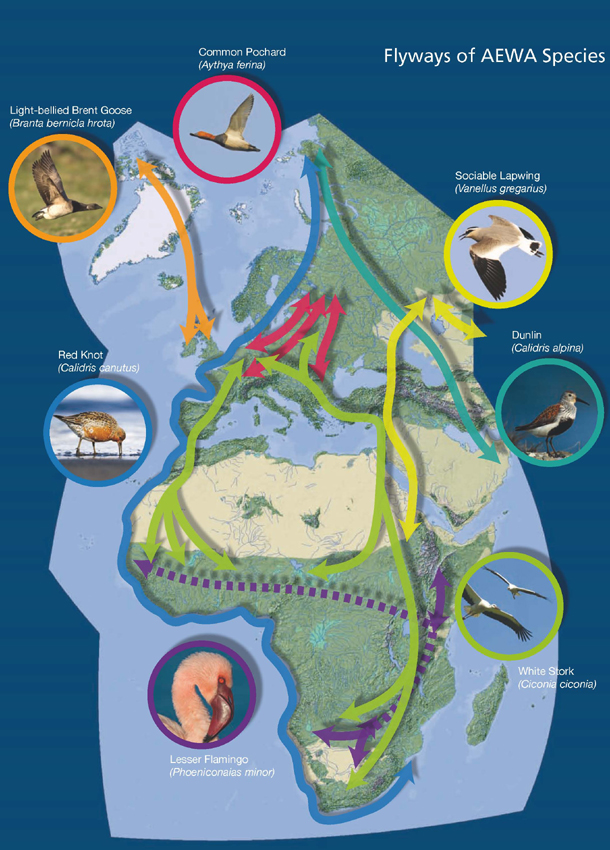 UNEP/AEWA
covers 255 species of birds that are ecologically dependent on wetlands
for at least part of their life cycle, including divers, pelicans, cormorants and flamingos. UNEP/AEWA
covers 255 species of birds that are ecologically dependent on wetlands
for at least part of their life cycle, including divers, pelicans, cormorants and flamingos.
AEWA stretches
across 119 Range States, from the northern reaches of Canada and
Greenland, across Europe, the Middle East and Central Asia to the
southern tip of Africa. Many of these countries have become Contracting
Parties - at this stage 71 countries and the European Union are
Contracting Parties to AEWA.
AEWA
brings these countries together, coordinates activities and projects,
holds meetings and provides the platform for international cooperation.
The measures that are
to be taken up by the Contracting Parties are specified in Action
Plans, which are legally binding. The plans detail key issues, such as species
and habitat conservation, management of human activities, research and
monitoring, education and information as well as legal and emergency
measures. UNEP/AEWA was developed under the
framework of the Convention on the Conservation of Migratory Species (UNEP/CMS). [Read More in the AEWA Information Leaflet]
The Convention on the Conservation of Migratory Species of Wild Animals (CMS)
 The Convention on the Conservation of Migratory Species of Wild Animals (also known as CMS or Bonn Convention) aims to conserve terrestrial, aquatic and avian migratory species throughout their range. It is an intergovernmental treaty, concluded under the aegis of the United Nations Environment Programme, concerned with the conservation of wildlife and habitats on a global scale. The Convention on the Conservation of Migratory Species of Wild Animals (also known as CMS or Bonn Convention) aims to conserve terrestrial, aquatic and avian migratory species throughout their range. It is an intergovernmental treaty, concluded under the aegis of the United Nations Environment Programme, concerned with the conservation of wildlife and habitats on a global scale.
[Read More About CMS]
BirdLife International - The World's Largest National NGO Partnership
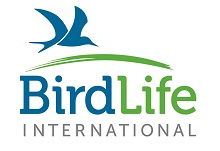 BirdLife
International is a partnership of 116 independent national
non-governmental organizations (NGOs). BirdLife
International is a partnership of 116 independent national
non-governmental organizations (NGOs).
They strive to conserve birds,
their habitats and global biodiversity. BirdLife International and their
partners operate in over one hundred countries and territories
worldwide. Their aim is to prevent the extinction of any bird species,
to maintain and possibly improve the conservation status of all bird
species and to protect sites and habitats important to birds.
BirdLife
International acts as a global networking partner and brings
organizations and people together to share and exchange skills and
experiences to achieve an overall goal – the conservation of birds and
their habitats. Since migratory birds cross many international borders
on their journey, it is crucial to have standardized conservation
policies and to act as one international team. BirdLife International
works with a growing network of people and organizations to advocate
policy change. They also believe that it is important to engage local
people in their work to achieve more effective and sustainable
conservation. Therefore, they work alongside local communities, adapt
conservation measures to local circumstances and help to integrate
conservation with social development and human wellbeing – for the
benefit of people and biodiversity.
BirdLife
International is a very important partner to UNEP/AEWA and the World
Migratory Bird Day Campaign.
[Read More About BirdLife International]
The World Migratory Bird Day Partner Organizations
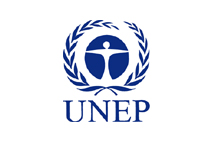   
  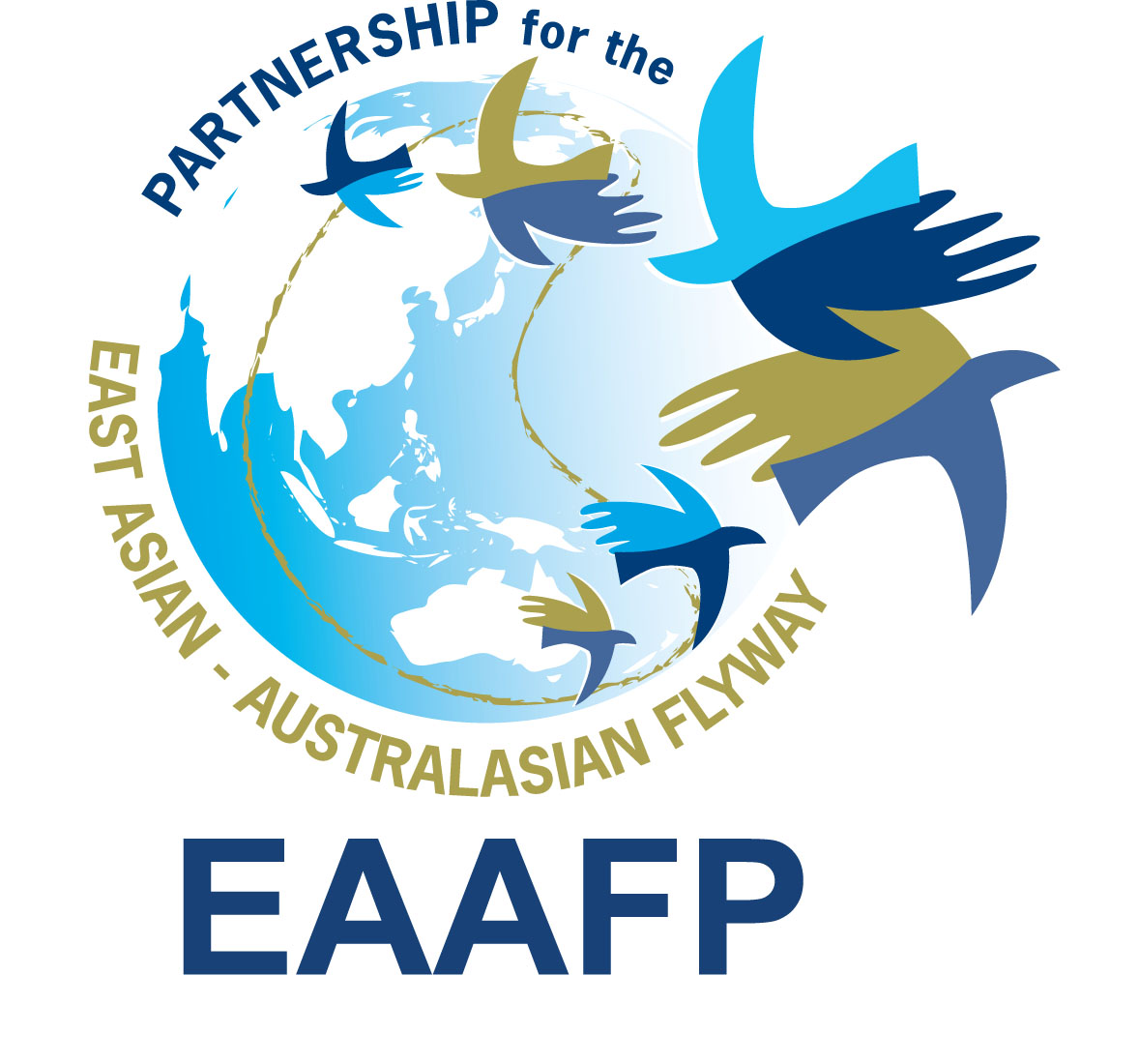 
Above
are the logos of the main World Migratory Bird Day Partners. These are
just a few of the many amazing networks comprised of governments,
conservation organizations and dedicated people that work together in
support of international migratory bird conservation. World Migratory
Bird Day is a joint campaign of these main partners aiming to inspire,
promote and help support migratory bird conservation efforts worldwide. [Read More about the WMBD Partners]
Join and Celebrate World Migratory Bird Day
 To
become a part of this year's campaign, register your own activity for
WMBD 2014 on this website! Celebrate migratory birds and raise awareness
about this year's theme 'Destination Flyways: Migratory Birds and Tourism'. To
become a part of this year's campaign, register your own activity for
WMBD 2014 on this website! Celebrate migratory birds and raise awareness
about this year's theme 'Destination Flyways: Migratory Birds and Tourism'.
[Register Your Activity]
For
more ideas for your own WMBD 2014 activity browse through the other
globally registered WMBD events which took place in past WMBD Campaigns!
[Events from Past WMBD Campaigns]
|


